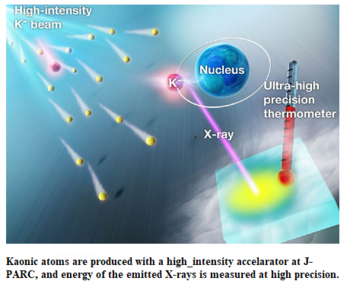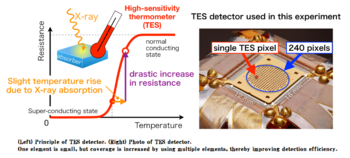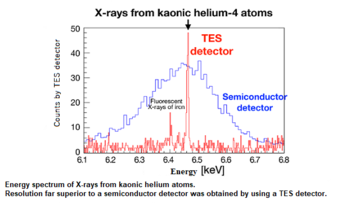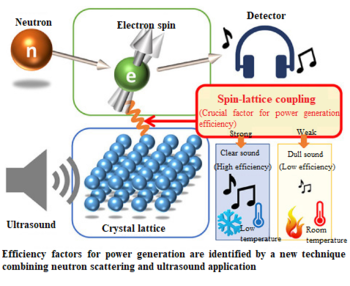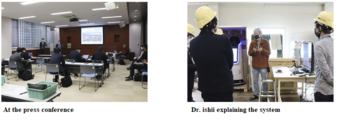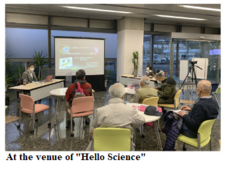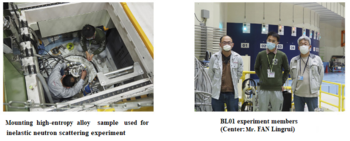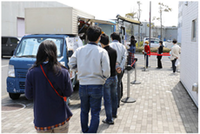J-PARC News April 2022 (Issue#204)
■Received the JNST Most Popular Article Award 2021 from the Journal of Nuclear Science and Technology (March 16)
An article published in the Journal of Nuclear Science and Technology (JNST), with Dr. Hiroki MATSUDA of the Nuclear Transmutation Division (currently affiliated with the National Institutes for Quantum Science and Technology) as the first author, was chosen to receive a JNST Most Popular Article Award 2021. This award was presented to the six most downloaded papers featured in the JNST in 2020. An award ceremony was held at the 2022 spring annual meeting of the Atomic Energy Society of Japan held on March 16–18, 2022.
With an accelerator-driven system (ADS), it is essential to evaluate radiation damage to materials such as beam windows bombarded by high-intensity proton beams. However, there is only poor experimental data on the displacement cross-sections of atoms which serve as the basis of evaluation, and the validity of evaluation calculation results has been unclear. By using the proton beam of J-PARC, the authors measured the displacement cross-sections of iron and copper to be used in the ADS, and succeeded in acquiring data on iron for the first time in the world. This paper provided these experimental data, and compared the experimental values with evaluation calculation values. The results will help to improve accuracy of materials damage evaluation used at high-energy accelerator facilities including ADS in the future.
For details, please see our July 1, 2020 press release:
https://j-parc.jp/c/press-release/2020/07/01000552.html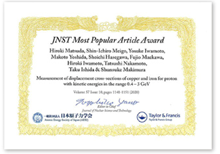
■Closing in on the Force that Creates the Atomic Nucleus using a High-Intensity Accelerator and an Ultra-High-Precision "Thermometer"—Dramatically Improving Precision of Measuring X-rays from Unusual Atoms— (March 28)
At the J-PARC Hadron Experimental Facility, we are trying to close in on the origins of the matter all around us by elucidating the properties of the "strong force"—a force which forms atomic nuclei by holding together the protons and neutrons in the atomic nucleus.
A team led by Tadashi HASHIMOTO, Assistant Principal Researcher at the JAEA, has investigated the strong force by using the high-intensity accelerator of J-PARC to produce "kaonic atoms", atoms in which a kaon is bound instead of an electron, and measuring the X-rays emitted from those atoms. The X-ray energy is determined by the force acting between the kaon and atomic nucleus. The strong force acts in addition to the electrical force between the kaons and the atomic nucleus, and the electrical force can be precisely calculated, so effects of the strong force can be derived by comparing with the measured X-ray energy in experiments. X-ray detectors must achieve both high energy resolution, and a large coverage area so that X-rays emitted in all directions can be captured to the greatest extent possible. This was achieved by using a multi-pixel detector based on high-resolution superconducting transition edge sensors (TES). The TES detector measures minute increases in temperature due to conversion of X-ray energy to heat using a high-sensitivity "thermometer". The “thermometer” called as TES employs the fact that electrical resistance drastically changes in response to tiny temperature changes in an extremely narrow temperature range at superconducting transition of the sensor material. This work established a technique that TES detectors can be used in the severe radiation environment of a high-intensity beam, and X-rays from the kaonic atoms were successfully measured at a precision 10 times better than before. In the future, a dramatic progress would be expected in quantitative understanding of the strong force by the X-ray measurements of various atoms with similar techniques.
For details, please see the J-PARC website:
https://j-parc.jp/c/press-release/2022/03/28000872.html
■Playing the Sound of Spin with Ultrasound, and Listening with Neutrons —Identifying Efficiency Factors in Power Generation using Spin with a New Method Combining Ultrasound and Neutrons— (March 29)
There are high expectations for the "spin Seebeck effect," where heat is converted to electric power using the spin of the electrons in a material, for applications such as independent power supplies for the microsensor networks that will serve as the foundation of the IoT ("Internet of Things") which is expected to be widely disseminated in the future. However, these power supplies are expected to be used near room temperature, and it is known that the actual voltage due to the spin Seebeck effect is far below the theoretical calculated value at temperatures of 100K or higher, and there has been a need to investigate the cause of this problem in order to achieve practical application.
Science Coordinator Shinichi SHAMOTO and Deputy Director Masato MATSUURA of the Comprehensive Research Organization for Science and Society (CROSS), Mitsuhiro AKATSU, Assistant Professor at Niigata University, Jun'ichi IEDA, Principal Researcher at the JAEA and others have strongly vibrated a crystal lattice of yttrium iron garnet (YIG) by applying ultrasound. YIG has been frequently used in research on the spin Seebeck effect, and investigated spin response by quasielastic neutron scattering using the Biomolecular Dynamics Spectrometer (BL02 DNA) at the Materials and Life Science Experimental Facility (MLF) of J-PARC. As a result of investigating temperature changes at peak intensity, deriving from electron spin in the YIG crystal lattice, the researchers discovered that spin-lattice coupling is suddenly reduced at temperatures of 100K or higher, and it was determined for the first time in the world that this is the crucial factor dominating power generation efficiency. Future objectives will include searching for materials with stronger spin-lattice coupling at room temperature, and greatly increasing the power generation efficiency due to spin. This will be done by using techniques combining this neutron scattering with ultrasound application.
For details, please see the J-PARC website:
https://j-parc.jp/c/press-release/2022/03/29000874.html
■Development of a Disaster-Prevention System Using ICT at the J-PARC MR* (Press Conference on March 30, Press Release on March 31)
Tobishima Corporation, the J-PARC Center, Sohgo Security Services Co., Ltd. (ALSOK), and the Tagashira Laboratory, Faculty of Informatics, Kansai University have jointly developed a disaster prevention system using ICT in the J-PARC MR tunnel. A press conference was held for the media, and one journalist each participated from seven newspaper companies and other media organizations. This system was explained by Yasuo KAWABATA, Manager of the Renewal Business Department, Civil Engineering Division, Tobishima Corporation, and Koji ISHII of the Accelerator Division, J-PARC Center.
The MR is the largest accelerator at J-PARC, and a large tunnel with a circumference of 1.6 km passes underground at a depth of 15 m. For the people working inside this accelerator tunnel, evacuation guidance and other safety measures are an important issue. However, electromagnetic waves do not penetrate inside the tunnel, so it is not possible to communicate via cellular networks or use GPS positioning, and use of ICT is limited. Therefore, we have developed: (1) An independent network for operation of applications in a closed space, (2) A system enabling understanding of user locations and traffic lines, and proper evacuation guidance in case of a disaster, (3) An ICT disaster-prevention application and system for locating workers using mobile terminals, and enabling efficient communication by managers and workers in an emergency, (4) An added remote work support function employing video calling, and an app function enabling daily use, such as using QR codes for radiation measurement, and (5) An autonomous robot equipped with video, thermal infrared, radiation dose, and other sensors. The specifics of each of these were explained. Going forward, we will strive to use this system in other J-PARC facilities besides the MR, and deployment in research facilities inside and outside Japan is being considered.
*Main Ring synchrotron
For details, please see the J-PARC website:
https://j-parc.jp/c/press-release/2022/03/31000876.html
■Held 2nd J-PARC Online Lecture Presentation and J-PARC Hello Science (March 25)
The 2nd Online Lecture Presentation " Diverse Types of Matter in the Universe Created by Elementary Particles called Quarks —J-PARC Tackles the Challenge of Elucidation," and the J-PARC Hello Science Event "Do Hypernuclei Exist in the Universe?" were held, with lectures by Hirokazu TAMURA, Professor at Tohoku University. As part of the lecture presentation, there was also a detailed presentation on experiments conducted at J-PARC by Shinya SAWADA, Deputy Division Head of the Particle & Nuclear Physics Division.
There are four major puzzles regarding the creation and evolution of matter in the universe: (1) Why were there more particles than antiparticles? (2) Why did protons and neutrons arise from quarks? (3) Where in the universe and how were all the atomic nuclei (elements) created? (4) What is the true nature of matter inside neutron stars? Research to elucidate (1), (2), and (4) is being conducted at the J-PARC Hadron Experimental Facility.
Atomic nuclei, at the center of the atoms which comprise matter, are made up of protons and neutrons in all objects on earth, and those protons and neutrons consist of up and down quarks, the two lightest quarks among the six types of quarks. In space, on the other hand, it has been found that the strange quark, the next heaviest quark after the up and down quarks, plays a crucial role. Red supergiant stars are formed at the end stage of stellar evolution. Before long, they cause a supernova explosion, and the star's remains become a black hole or neutron star. A neutron star is the densest object in the universe, with a radius of about 10–15 km, and a mass 1–2 times that of the sun. The part near the surface is made of neutrons, but the core part is thought to be an unknown material containing strange quarks. At the J-PARC Hadron Experimental Facility, research is being done to create a "mini neutron star" on earth and explore its properties in order to elucidate this unknown type of matter.
For details on the 2nd J-PARC Online Lecture Presentation, please follow the link below:
http://www.j-parc.jp/c/information/2022/02/28000836.html
■Overseas Users Resume Experiments at J-PARC Facilities for the First Time in Two Years (March 26)
Restrictions on entry into Japan from overseas, introduced due to COVID-19, were relaxed in March 2022, and Mr. FAN Lingrui from the City University of Hong Kong (China) came to Japan, and carried out experiments using BL01 4SEASONS at MLF. The last visit by an overseas user to MLF was March 2020, so this was the first time in two years that an overseas user with foreign citizenship was welcomed at J-PARC. Mr. FAN had to prepare samples while his university was closed due to the COVID-19 pandemic. His visa procedure was also delayed, and there were worries about his trip to Japan. Mr. FAN, who overcame these difficulties to get to J-PARC, successfully completed inelastic neutron scattering experiments for research on the phase stability of high-entropy alloys from March 26 to April 1.
At the MLF, users from overseas are scheduled to visit and conduct experiments starting in April. All of the staff at J-PARC hope that COVID-19 will subside soon, so that many overseas users can conduct experiments at J-PARC in the future.
■Sanpo-michi #22 : The Food Trucks Give Us Meeting by Chance
The staff cafeteria is located 2 km from the J-PARC site, so many staff bring their own homemade lunches, or rely on catered box lunches. As the COVID-19 pandemic continues, you see people here and there eating lunch alone in the lounge. Around that time, food trucks stop in front of the J-Lounge twice a month, offering warm lunches and pasta. The food truck staff provide the meals after taking customer orders, so it takes a little time and line forms.
J-PARC's expansive site is dotted with accelerators and facilities, and there aren't many opportunities for chance meetings between people from different departments. Against that backdrop, there are unexpected encounters in these lines. For example, thanks to these lines, two researchers who were teacher and student in their university laboratory found out that they are currently working in Experimental Hall #1 and Experimental Hall #2 on each side of the MLF's neutron target, and two neighbors who only casually greeted each other found out they were in a user-staff relationship.
Incidentally, lunchtime is limited, so it's impossible to engage in long talks. Most people only exchange a few words, return to the lounge, and eat lunch alone while looking at a PC or smartphone. Even so, some were able to spend their lunch break with the fresh feeling of having made a new discovery. J-PARC is a big place, but in some ways it's also a small world.

